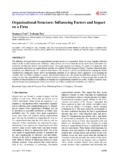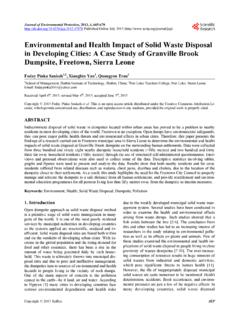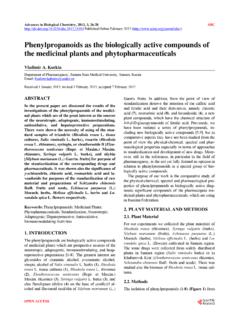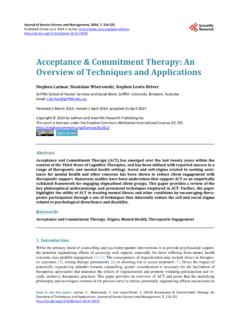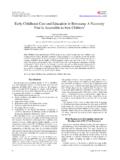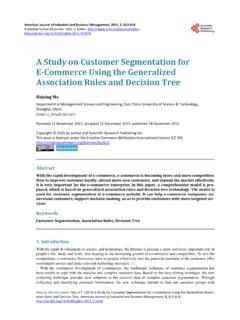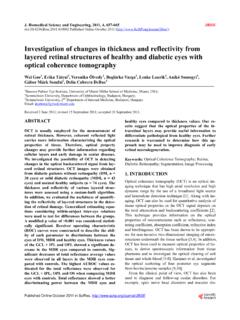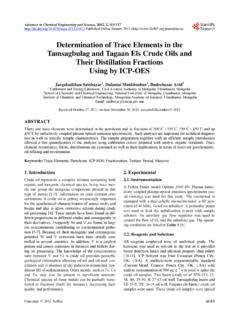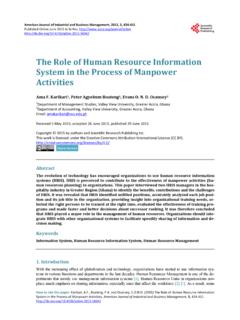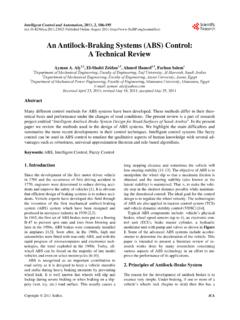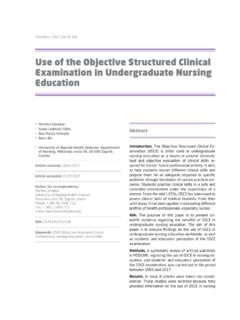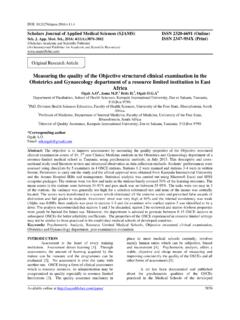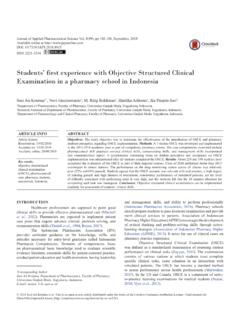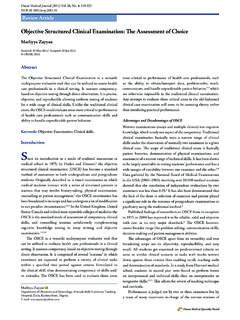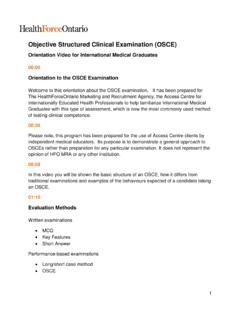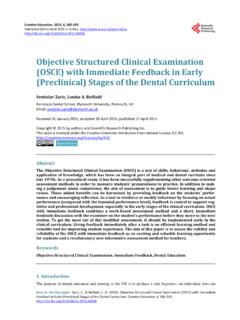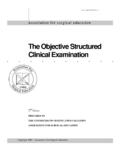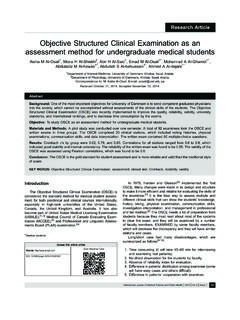Transcription of Implementation of Objective Structured Clinical ...
1 Creative Education 2013. , , 48-53 Published Online October 2013 in SciRes ( ) Copyright 2013 SciRes. 48 Implementation of Objective Structured Clinical examination for Assessing Nursing Students Clinical Competencies: Lessons and Implications* Patricia Katowa-Mukwato, Lonia Mwape, Marjorie Kabinga-Makukula, Prudencia Mweemba, Margaret C. Maimbolwa Department of Nursing Sciences, School of Medicine, University of Zambia, Lusaka, Zambia Email: Received August 8th, 2013; revised September 8th, 2013; accepted September 15th, 2013 Copyright 2013 Patricia Katowa-Mukwato et al.
2 This is an open access article distributed under the Creative Commons Attribution License, which permits unrestricted use, distribution, and reproduction in any medium, provided the original work is properly cited. Objective Structured Clinical examination (OSCE) as a performance-based assessment method is a well established student assessment tool. Its popularity in the assessment of Clinical competence is well docu- mented and prominent in situations where reliability and content validity are fundamental. In this paper, we describe the Implementation of OSCE in the Department of Nursing Sciences; University of Zambia for assessment of nursing students Clinical competencies.
3 The Implementation process followed an eight step-approach from which several lessons were drawn and implications were generated. Major lessons in- cluded the need for adequate preparation of faculty and students, which is a fundamental ingredient to ensure reliability of the examination , and in minimizing stress and anxiety respectively. Following the Implementation we acknowledged that OSCEs are suitable for testing Clinical , technical and practical skills which may not be adequately assessed through traditional assessment methods as they possess the ability to improve the validity and reliability of assessments.
4 Nevertheless, careful consideration should be taken to avoid entirely relying on OSCE as the only means of assessing Clinical competencies. Keywords: Clinical Competence; Objective Structured Clinical examination ; Assessment; Nursing Students Introduction Clinical Competence is a complex concept and debates con- tinue about the most appropriate definition and method of as- sessment (Evans, 2008). Watson et al., (2002) suggest that competence is a nebulous concept defined in deferent ways by different people.
5 Its relationship with other concepts such as capability, performance, proficiency and expertise make it even more difficult to define. Earlier Gonzi (1994) described three ways of understanding competence: 1) tasks related skills, 2) patterning to generic attributes essential to performance and 3) the bringing together of a range of general attributes such as knowledge, skills and attitudes appropriate for professional practice. Later the Australian Nurses and Midwifery Council (2005) described competence in a more holistic way as a com- bination of skills, knowledge, attitudes, values and abilities that underpin effective and/or superior performance in a profession.
6 The above definitions underscore the complexity and multi- facetedness of Clinical competence. The complex nature of cli- nical competence consequently poses a challenge in isolating or identifying suitable assessment methods that are able to meas- ure all its attributes as well as maintaining validity, reliability and objectivity. Affirming the challenges in assessing Clinical competence for nursing students, Levette-Jones and others (2010) stated that the challenge of validity, reliability, subjectivity and bias in measuring Clinical competence has confronted universi- ties for many years.
7 Since inception in 1978, the Department of Nursing Sciences at the University of Zambia, utilized Direct Observation of Procedural Skills (DOPS) for assessment of nursing students Clinical competences for both formative and summative pur- poses. DOPS is a method for assessing procedural competence through direct observation by faculty (Holmboe & Hawkins, 2008). It was considered sufficient in assessment of Clinical competence as the Department of sorely admitted Registered Nurses with diploma to upgrade to Bachelor s Degree.
8 These students were already practicing nurses and had been certified competent to practice nursing by the regulatory body (General Nursing Council of Zambia). Some students had also attained post registration qualifications such as Midwifery, Operating Theatre Nursing and Mental Health Nursing. Using DOPs, each student was assessed on one procedure deemed appropriate by the examining faculty. Selection of procedures was sorely de- termined by the examiner as well as the availability of patients requiring such a procedure, as opposed to curricular core com- petencies and examination blue prints.
9 There was often a lack of transparency about the objectives of the assessment and the competencies required to succeed (Marwaha, 2011). In addition, the lack of a clear marking system resulted in variability be- tween examiners. Although DOPS was considered feasible and *Competing Interest: The Authors declare that there is no competing inter-est. P. KATOWA-MUKWATO ET AL. acceptable by faculty and students, its inherent characteristics made it fail to meet the principles of reliability, content validity and standardization.
10 In 2010 the Department of Nursing Sciences implemented a competence-based curriculum and admitted the first cohort of pre-service students. Consequently it became necessary to re- view the Clinical assessment methods to facilitate the imple- mentation of those techniques that are authentic for measuring and enhancing Clinical competence. As a result, in the 2012/ 2013 academic year, the department implemented the Objective Structured Clinical examination (OSCE) for assessment of Clinical competence.
